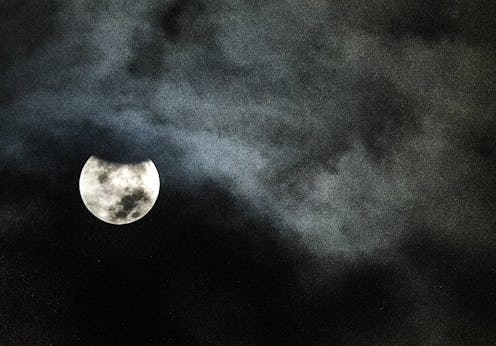Good news for all you astronomy nerds and witches: if you missed the annular solar eclipse on Sept. 1, you have another opportunity to witness a large-scale astronomical event. This time, it's a penumbral lunar eclipse, and it's occurring on Sept. 16, 2016. But, yes, I know: What does a penumbral lunar eclipse mean? Does it honestly sound kind of made up to anyone else? It's not, though. I promise. And it means that there's going to be plenty of cool stuff in store.
On average, there are four eclipses per year — two lunar and two solar, usually arriving in a solar-lunar pair. This year, we've already had three: Two in March, and a solar eclipse on Sept. 1. On Sept. 16, we'll witness (well, some of us will witness) the last eclipse of 2016, a penumbral lunar eclipse. It's not going to be as showy as the Sept. 1 event, in which the sun became, for a few minutes, a giant, flaming ring in the sky, but it will still be cool, because eclipses are always cool.
A lunar eclipse occurs when the Earth passes between the moon and the sun, blocking the sun's rays — the reflections of which are responsible for the moon's glow — and throwing its shadow across the moon. It can only occur during a full moon, and only when the Earth, moon and sun are aligned in a straight shot. Very spooky-scary, no? It's perfect for fall, I'd argue, especially since it's almost Halloween season.
There are three kinds of lunar eclipses (total, partial and penumbral), but penumbral eclipses are by far the most subtle. As opposed to a partial eclipse, when it looks like someone took a bite out of the moon, or a total eclipse, when, per its name, we're plunged into total darkness, a penumbral eclipse catches just the outer shadow of the earth. This is because the alignment of the Earth, moon and sun is juuuuuust a tiny but imperfect. At mid-eclipse, if you look closely, it will usually appear to be some darker shading on the side of the moon. A contour, if you will.
The eclipse, which will begin around 1 p.m. EST and continue for about three hours, won't be visible from the United States, because duh, it will be in the daytime. However, it will be noticeable for Europe, Asia, Australia, Africa, and the Western edge of South America.
Unsurprisingly, eclipses are an equally big deal in the astrology world. They tend to be regarded as "wild cards," with their overall presence being one that uproots, that forces us forward and burns the bridge behind us. According to Susan Miller of Astrology Zone, lunar eclipses are essentially "full moons on steroids."
While this, obviously, can be scary, and can have negative consequences (big changes! unexpected events!), it does shed a new light on circumstances in our lives, albeit with a heavy hand. A lot of the time, more often than I think most of us are willing to admit, we need that extra push, that tough love, to really get going.
Well, my dudes, that push is here. Take advantage of it. Get moving.
Images: Giphy (2)
